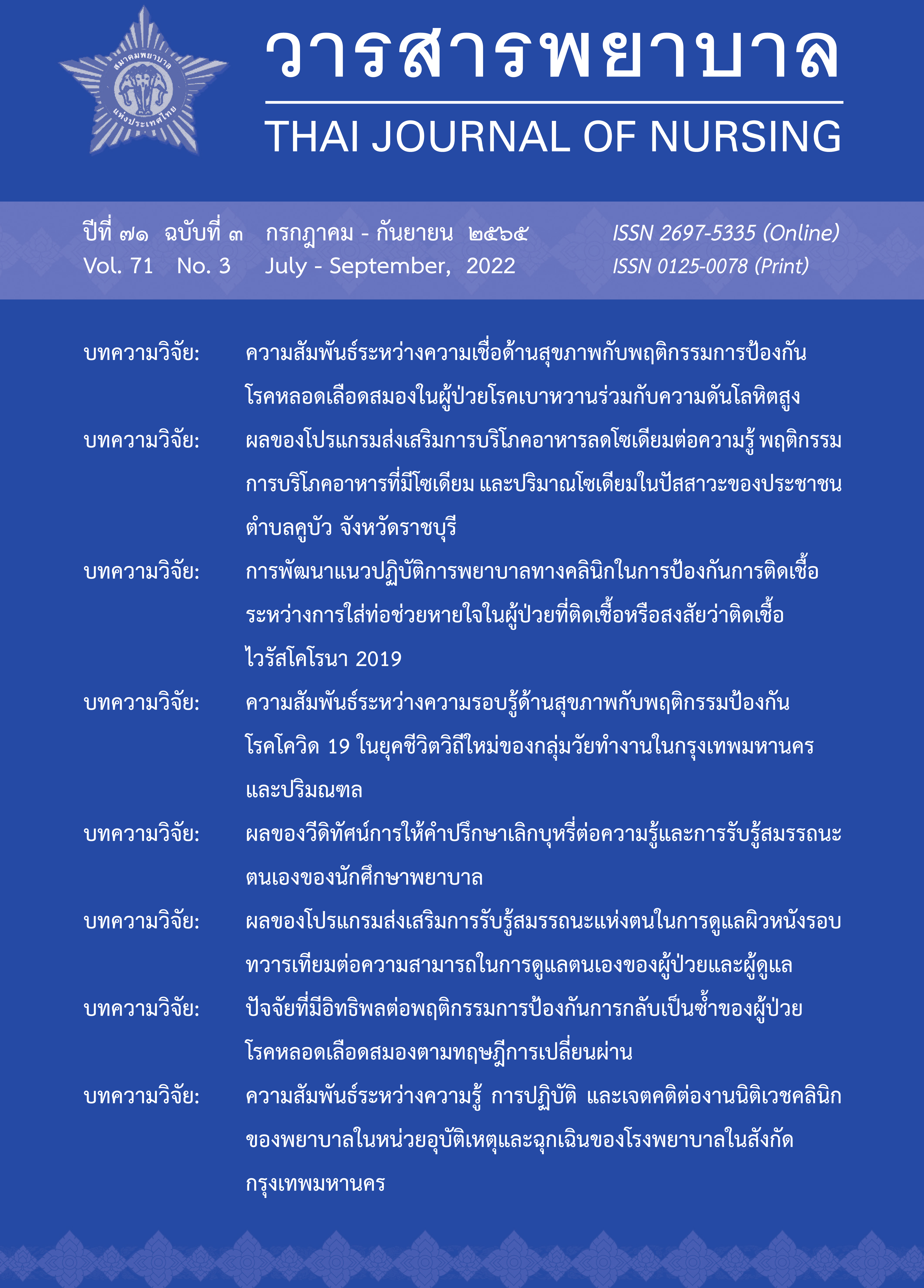ความสัมพันธ์ระหว่างความรู้ การปฏิบัติ และเจตคติต่องานนิติเวชคลินิกของพยาบาล ในหน่วยอุบัติเหตุและฉุกเฉินของโรงพยาบาลในสังกัดกรุงเทพมหานคร
Main Article Content
บทคัดย่อ
การวิจัยเชิงพรรณนานี้มีวัตถุประสงค์เพื่อหาความสัมพันธ์ระหว่างความรู้ การปฏิบัติ และเจตคติต่องานนิติเวชคลินิกของพยาบาล ในหน่วยอุบัติเหตุและฉุกเฉิน โรงพยาบาลในสังกัดกรุงเทพ มหานคร และเปรียบเทียบความรู้และการปฏิบัติงานนิติเวชคลินิกระหว่างพยาบาลในโรงพยาบาลที่ให้บริการระดับทุติยภูมิและตติยภูมิ กลุ่มตัวอย่าง จำนวน 73 คน เลือกโดยการสุ่มตัวอย่างแบบง่าย เก็บข้อมูลโดยใช้แบบทดสอบและแบบสอบถาม ในช่วงเดือนมกราคม ถึง เดือนกุมภาพันธ์ พ.ศ. 2563 ผลการวิจัยมีดังนี้ 1) พยาบาลมีความรู้อยู่ในระดับน้อย และการปฏิบัติงานนิติเวชคลินิกอยู่ในระดับปานกลาง 2) ความรู้มีความสัมพันธ์ทางบวกระดับต่ำกับการปฏิบัติงานนิติเวชคลินิก (r = 0.308) อย่างมีนัยสำคัญทางสถิติที่ระดับ .01 และ 3) พยาบาลในโรงพยาบาลที่ให้บริการระดับทุติยภูมิและตติยภูมิ มีความรู้และการปฏิบัติงานนิติเวชคลินิกไม่แตกต่างกัน (p > .05)
Article Details

อนุญาตภายใต้เงื่อนไข Creative Commons Attribution-NonCommercial-NoDerivatives 4.0 International License.
เอกสารอ้างอิง
ชูศรี วงศ์รัตนะ. (2560). เทคนิคการสร้างเครื่องมือวิจัย: แนวทางการนำไปใช้อย่างมืออาชีพ (พิมพ์ครั้งที่ 1). กรุงเทพมหานคร: อมรการพิมพ์.
ปัจจิกาล สุวรรณชาศรี, ศิริรัตน์ ชูสกุลเกรียง, ศุภชัย ศุภลักษณ์นารี, และอาภา อิ่มสิน. (2559). ความเข้าใจของพยาบาลห้องอุบัติเหตุและฉุกเฉินโรงพยาบาลพระมงกุฎเกล้าเกี่ยวกับหลักฐานทางนิติเวชและนิติวิทยาศาสตร์. Veridian E-Journal Science and Technology Silpakorn University, 3(1), 1-12.
มหาวิทยาลัยนเรศวร คณะพยาบาลศาสตร์. (2561). ประมวลรายวิชา 501479 กฎหมายและจริยศาสตร์สำหรับพยาบาล. สืบค้นเมื่อ 10 เมษายน 2562, จาก http://www.nurse.nu.ac.th/webdpmnr/documents/course/ nr4/501479.pdf
มหาวิทยาลัยวลัยลักษณ์ สำนักวิชาพยาบาลศาสตร์. (2563). รายละเอียดของหลักสูตรระดับปริญญาตรีหลักสูตรพยาบาลศาสตรบัณฑิต (หลักสูตรปรับปรุง พ.ศ. 2563) (มคอ.2). สืบค้นเมื่อ 1 ตุลาคม 2563, จาก https://cur-das.wu.ac.th/backEnd/myfile/attDetailCourse/nurse63.pdf
วรางคณา สาริพันธุ์. (2554). แนวทางปฏิบัติของพยาบาลในการเก็บพยานหลักฐานผู้ป่วยคดีในหน่วยอุบัติเหตุและฉุนเฉินโรงพยาบาลรามาธิบดี. (วิทยานิพนธ์ปริญญามหาบัณฑิต ไม่ได้ตีพิมพ์). มหาวิทยาลัยมหิดล, นครปฐม.
วิรัติ พานิชย์พงษ์, และสุพจน์ แจ่มสุวรรณ. (2550). นิติเวชคลินิก. ใน คณะกรรมการฝึกอบรมเพื่อความรู้ความชำนาญในการประกอบวิชาชีพเวชกรรม สาขานิติเวชศาสตร์. (บ.ก.). แนวทางในการปฏิบัติทางนิติเวชศาสตร์ (น. 87-115). กรุงเทพมหานคร: ผู้แต่ง.
ประกาศสำนักนายกรัฐมนตรีเรื่อง การประกาศแผนการปฏิรูปประเทศ. (2561, 6 เมษายน). ราชกิจจานุเบกษา. เล่ม 135 ตอนที่ 24 ก, หน้า 1-201.
ไสว นรสาร. (2560). การปฏิบัติการพยาบาลกับงานด้านนิติเวชศาสตร์. ใน แสงทอง ธีระทองคำ, และไสว นรสาร. (บ.ก.). กฎหมายสำหรับพยาบาล (ฉบับเรียบเรียงครั้งที่ 2 พิมพ์ครั้งที่ 1, น. 223-240). กรุงเทพมหานคร: บียอนด์ เอ็นเทอร์ไพรซ์.
Best, J. W., & Kahn, J. V. (2006). Research in education (10th ed.). Cape Town: Pearson Education.
Bloom, B. S., & Krathwohl, D. R. (1956). Taxonomy of educational objectives: The classification of educational goals. New York: McKay.
Cochran, W. G. (1977). Stratified random sampling. In W. G. Cochran (Ed.), Sampling techniques
(pp. 89-96). New York: John Wiley & Sons.
Donaldson, A. (2019). Forensic clinical nurses in emergency departments: An emerging need for New Zealand. Kai Tiaki Nursing Research, 10(1), 54-58.
Donaldson, A. E. (2020). New Zealand emergency nurses knowledge about forensic science and its application to practice. International Emergency Nursing, 53, 100854.
Feizi Nazarloo, L., Sedghi Sabet, M., Jafaraghaee, F., Kazemnezhad Leyli, E., Rahbar Taromsari, M., & Jolly, A. (2017). Emergency department nurses's knowledge about forensic nursing. Journal of Holistic Nursing and Midwifery, 27(3), 27-36. doi:10.18869/acadpub.hnmj.27.3.27
Hoyt, C. A. (1999). Evidence recognition and collection in the clinical setting. Critical Care Nursing Quarterly, 22(1), 19-26. doi:10.1097/00002727-199905000-00004
Lynch, V. A., & Duval, J. B. (2011). Forensic nursing science (2nd ed.). St. Louis, MO: Mosby/Elsevier.
Mageto, I. G., Omoni, G., Cabelus, N. B., & Inyega, J. O. (2017). Preparedness and practice of forensic nursing in Kenya. International Journal of Nursing Education, 9(3), 64-68. doi:10.5958/09749357.2017.00072.1
Ozsaker, E., Kaya, A., Okgun Alcan, A., Yavuz van Giersbergen, M., & Aktas, E. O. (2020). Forensic cases in the operating room: Knowledge and practices of physicians and nurses. Journal of Perianesthesia Nursing, 35(1), 38-43. doi:10.1016/j.jopan.2019.06.010
Shapiro, P. (2011). Forensic first response: approach for emergency medical personnel. In V. A. Lynch & J. B. Duval (Eds.), Forensic nursing science (pp. 123-133). St. Louis: Elsevier.
Silva, J. O. M., Santos, L. F. S., Dos Santos, S. M., da Silva, D. P., Santos, V. S., & de Melo, C. M. (2020). Preservation of forensic evidence by nurses in a prehospital emergency care service in Brazil. Journal of Trauma Nursing, 27(1), 58-62. doi:10.1097/JTN.0000000000000483


